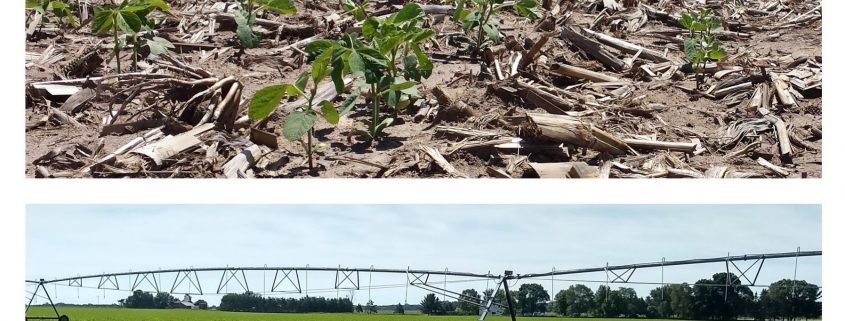Early Season Soybean Irrigation
Authored by Emma Matcham and Shawn P. Conley
Did you know that roughly 500,000 acres of WI cropland are irrigated? Interestingly, most of WI irrigated land is used for vegetable (potato, sweet corn, etc.) or seed corn production. You might notice that soybean is not highlighted on the preceding list, however soybean is frequently grown in rotation or used as a “set up” crop with potatoes and corn under these irrigation systems.
Given the Covid-19 crisis we are seeing more irrigated vegetable production going to other crops such as soybean. Here are some things to keep in mind for your early-season soybean irrigation planning.
If you have soybean planted under irrigation this year, the good news is that you can use the same irrigation planning tools you use for other crops to grow a great soybean crop. The Wisconsin Irrigation Schedule Planner is designed for a wide range of crops including soybean, potato, sweet corn, field corn, alfalfa, and more! Find out more about WISP and evapotranspiration data here: https://fyi.extension.wisc.edu/cropirrigation/wisconsin-irrigation-scheduling-program-wisp/
If you’ve already planted but your soybeans aren’t up yet: Phew… you just missed the cold weather! However, keep an eye out for crusting, especially if you got hit with heavy rains last week. On sandy soils with thin crusts, soybeans can usually break the crust on their own. But, if your crust is thicker or you’re on finer soils, you can use a shallow rotary hoeing or even apply some water to help get the beans up.
If you’ve planted and your beans are up: cold temperatures around the state were largely either not prolonged enough or cold enough to damage most emerged soybeans, but microenvironments exist and it never hurts to check. This video shows you what to check for regarding early season damage symptoms, including freeze.
If you discovered that you have frost damage but don’t know if you should replant, remember a stand of ~100k plants/acre at harvest is enough to maximize yield in most situations. Furthermore, our data shows that soybean stands as low as 50k plants/acre typically don’t require a replant. Here’s an article to help you make that choice: Soybean Replant Decisions: Just the Facts Jack.
If you’re ready to plant: and the weather looks dry in your area over the next few weeks. In order to get soybean out of the ground, seeds need to imbibe water and start germinating. Be prepared to provide 0.2-0.5 inches of water to moisten soils to a depth of around 6 inches, which is the length of soybean roots at growth stage VE.
Moving into the early season, here’s some additional information to keep in mind. Most crops begin to experience moisture stress at around 50% soil water deficit, but soybean can handle drier conditions during vegetative growth and flowering without seeing yield decreases. Lyndon Kelley at MSU, suggests that you can reach a 75% soil water deficit before R3 (pod formation) and still not experience yield loss.
In Nebraska, and irrigated finer soils, Jim Specht recommends withholding water until soybeans reach the R3 growth stage.
In Wisconsin we’re primarily irrigating on coarse sandy loams that simply cannot hold substantial water reserves, so withholding irrigation entirely until R3 isn’t typically advisable. Instead, consider setting your deficit threshold somewhere between 50 and 75% without impacting your final seed yield.
Beyond reducing the energy and water demands of your soybeans, there might be some side benefits to reducing early-season irrigation. A soybean crop that is exposed to extreme early season irrigation tends to invest less energy in their root systems and instead grow tall and leafy, making them more susceptible to lodging and diseases like white mold.
Stay tuned as we will continue this conversation about irrigating soybean when we approach R3 (pod formation) soybean.




